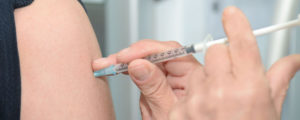Press Release
Jan 31, 2019
Scared of needles or pain? Study finds Virtual Reality could help

Peer Reviewed | Case Report | People
Virtual reality (VR) could replace local anaesthesia to reduce pain and discomfort during simple medical procedures, and could help people with needle phobia, according to research published in the British Journal of Dermatology.
Minor treatments which can be administered at the bedside, such as wart destruction and cleaning of an open wound, are commonplace in medicine. A current solution for the pain associated with these practices is an injection of a local anaesthesia. However, this also causes pain and anxiety in patients as well as being associated with a risk of causing an eczema flare, light-headedness, tinnitus and occasionally systemic toxicity.
Virtual reality is a computer-generated, interactive three-dimensional (3D) environment experienced by wearing a head-mounted device, goggles and noise cancelling headphones connected to a smartphone. The simulated environment is multi-sensory often incorporating auditory, visual and touch settings.
In this study from the US, nine patients, aged between four and 70 years, were provided with VR headsets during minor procedures that would normally be painful and may require local anaesthetic. The researchers found that all participants included in the study experienced minimal pain, with half experiencing no pain at all. All participants, regardless of age, reported finding the technology simple to use.
Seven patients were undergoing wart destruction, one was having a venous leg ulcer cleaned and another having an anaesthetic injection for a skin biopsy.
The patients were cleaned and prepped as standard, and then fitted with a VR system. After a few minutes of use, the procedure was commenced. Upon completion, each patient was asked about their experience and level of pain and the provider of the procedure gave a score based upon the patients’ reactions.
The provider score of patient response to treatment was ranked between zero and four. A score of zero meant that the patient did not retract the treated limb and demonstrated no signs of pain. A score of four was given if the patient retracted the limb, demonstrated severe signs of pain and asked to stop the procedure.
Five out of the nine patients were ranked a provider score of zero, having demonstrated no pain response. The highest provider score from all of the patients studied was just two.
When asked, all patients said they experienced minimal pain, with half describing that they felt no pain at all, accompanied by surprise that the procedure was over.
VR is believed to have this positive effect on pain due to the multi-sensory, immersive nature of the simulated environment. This acts as a distraction in the brain, which interacts with how pain is perceived.
Dr. Hadar Lev-Tov of the University of Miami, one of the authors of the study, said:
“Most people will have undergone some type of minor medical procedure in their life such as wart removal, wound cleaning or injections. Although minor, these treatments are often uncomfortable and for some people, for example those with a phobia of needles, they can cause considerable anxiety.
“Virtual Reality is a relatively recent technology, and as such research into this area is new. However, distraction techniques have long been used by doctors when performing these procedures – Virtual Reality is just particularly effective at taking the patients from the here-and-now and immersing them in another experience. So effective in fact, that during our research some patients were surprised when their treatments were over.
“Especially encouraging is a new generation of VR devices which are now available, affordable and can be easily incorporated into clinical practice. At the same time, we need to expand research into the safety of using VR as it is not known for example how people with seizure disorders or vertigo respond to this immersive environment.”
Holly Barber of the British Association of Dermatologists said:
“There are a huge number of people for whom minor medical procedures, such as getting injections, or having stitches, are incredibly stressful. This leads to people putting them off for as long as possible, potentially endangering their health. This research is at a very early stage, but it suggests that VR could be a way to solve this problem. I suspect that for most people who wish to avoid these sorts of treatments, the idea is worse than the actual process.”
It is hoped that larger randomised control trials focusing on VR in bedside procedures will expand upon and confirm the results of this study.
-Ends-
Study details:
The use of Virtual Reality for Bedside Procedures
P.A. Hirt1 and H. Lev-Tov1
1Department of Dermatology and Cutaneous Surgery, University of Miami, Miller School of Medicine.
Citation: P.A. Hirt and H. Lev-Tov (2019), The use of Virtual Reality for Bedside Procedures. Br J Dermatol. DOI 10.1111/bjd.17682.
Link to full study: https://onlinelibrary.wiley.com/doi/abs/10.1111/bjd.17682?af=R
For more information please contact the media team: comms@bad.org.uk, 0207 391 6084. Website: www.bad.org.uk
About us:
The British Association of Dermatologists is the central association of practising UK dermatologists. Our aim is to continually improve the treatment and understanding of skin disease. For further information about the charity, visit www.bad.org.uk
The British Association of Dermatologists publishes two world-renowned dermatology journals, both published by Wiley-Blackwell. The British Journal of Dermatology is one of the top dermatology journals in the world, and publishes papers on all aspects of the biology and pathology of the skin. http://onlinelibrary.wiley.com/journal/10.1111/(ISSN)1365-2133